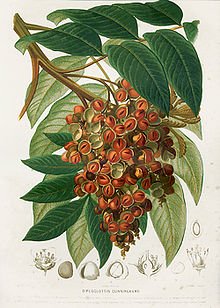Diploglottis

Diploglottis is a genus of 10 species of trees known to science, constituting part of the plant family Sapindaceae. They grow naturally in rainforests and margins of adjoining humid forests in eastern Australia and New Guinea.[2] Some species are known as native tamarind or small-leaved tamarind; they have no direct relationship with the true tamarind.
One Australian species, D. australis is grown as a street tree in the Northern Rivers area of New South Wales, principally Lismore and is known locally as the native tamarind.
Another endemic Australian species is D. campbellii, also known as the small-leaved tamarind, is rare and threatened and is restricted to a small number of sites each with a maximum of three trees per site. There are a total of 42 known mature wild trees in south-east Queensland and north-eastern New South Wales. However, the tree, as a seedling, is readily available from nurseries in the Northern Rivers area of New South Wales, and in south-eastern Queensland. The small-leaved tamarind grows to 30 metres and has a compact canopy, making it good to use as a screening tree. It has small three-lobed fruit capsules. The fruit is edible and is commercially produced as bushfood. It is red when ripe and can be made into jam.
